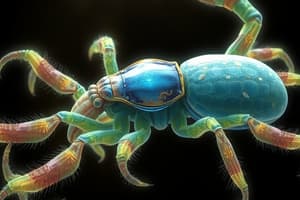Podcast
Questions and Answers
What is a key distinction between incomplete metamorphosis and complete metamorphosis?
What is a key distinction between incomplete metamorphosis and complete metamorphosis?
- Incomplete metamorphosis occurs only in aquatic species.
- Complete metamorphosis includes a pupa stage. (correct)
- Both types of metamorphosis have similar adult forms.
- Incomplete metamorphosis has a larval stage that looks different from adults.
Which of the following statements describes the body characteristics of arthropods?
Which of the following statements describes the body characteristics of arthropods?
- They have a segmented body with a soft exoskeleton.
- Their body is divided into a head, thorax, and abdomen. (correct)
- They possess a closed circulatory system.
- Arthropods lack jointed appendages.
What is the primary function of tube feet in sea stars?
What is the primary function of tube feet in sea stars?
- Reproduction.
- Gas exchange.
- Locomotion and feeding. (correct)
- Digestion of food.
Which phylum do crustaceans belong to?
Which phylum do crustaceans belong to?
What distinguishes millipedes from centipedes?
What distinguishes millipedes from centipedes?
Flashcards
Ecdysozoa
Ecdysozoa
A major group of animals characterized by molting, a process where they shed their outer layer to grow. This group includes nematodes and arthropods.
Nematodes vs. Annelids
Nematodes vs. Annelids
Nematodes are round worms with a cylindrical, unsegmented body and a complete digestive system. Annelids are segmented worms with a more complex body structure and a closed circulatory system.
Arthropod Body
Arthropod Body
Arthropods have a segmented body with a hard exoskeleton, jointed appendages, and a well-developed nervous system. They are divided into three major body segments: head, thorax, and abdomen.
Open vs. Closed Circulatory System
Open vs. Closed Circulatory System
Signup and view all the flashcards
Sea Star Body Plan
Sea Star Body Plan
Signup and view all the flashcards
Study Notes
Ecdysozoa
- Ecdysozoans shed their exoskeletons (ecdysis)
- Two phyla studied: Nematoda (roundworms) and Arthropoda (insects, spiders, crustaceans)
Nematoda vs. Annelida
- Nematodes lack the segmented body and coelom of Annelida (segmented worms).
Arthropod Body
- Composed of segments
- Exoskeleton for support and protection
Arthropod Appendages
- Modified for various functions (e.g., locomotion, feeding, sensory)
Open vs. Closed Circulatory Systems
- Open: Blood not always contained in vessels
- Closed: Blood always in vessels
- Arthropods have open circulatory systems.
Millipedes vs. Centipedes
- Millipedes have two pairs of legs per segment
- Centipedes have one pair of legs per segment
Insect Success
- Flight and complete metamorphosis are key factors enabling insects to thrive
Incomplete vs. Complete Metamorphosis
- Incomplete: Gradual change in form
- Complete: Distinct larval, pupal, and adult stages.
Crustaceans
- Belong to the phylum Arthropoda
- Examples: Crabs, lobsters, shrimps
Deuterostomia
- Includes echinoderms (e.g., sea stars) and chordates (e.g., vertebrates)
Sea Star Body Plan
- Radial symmetry
- Water vascular system for locomotion, feeding, and respiration. Water vascular system is unique to echinoderms
Sea Star Tube Feet
- Used for locomotion, capturing prey, and attachment.
Echinoderms
- Examples: Sea stars, sea urchins, brittle stars, sea cucumbers.
Studying That Suits You
Use AI to generate personalized quizzes and flashcards to suit your learning preferences.
Description
Explore the fascinating world of Ecdysozoa, focusing on the two main phyla: Nematoda and Arthropoda. Understand the differences between nematodes and annelids, as well as the various circulatory systems and body structures in arthropods. Test your knowledge on insect success and the stages of metamorphosis.




